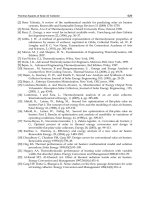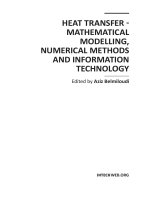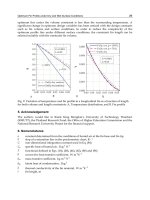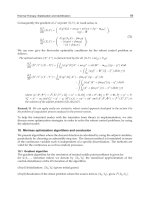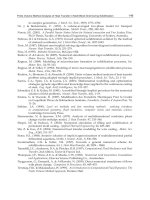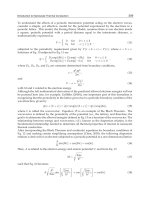Heat Transfer Theoretical Analysis Experimental Investigations and Industrial Systems Part 17 ppt
Bạn đang xem bản rút gọn của tài liệu. Xem và tải ngay bản đầy đủ của tài liệu tại đây (1.79 MB, 26 trang )
The Rate of Heat Flow through Non-Isothermal Vertical Flat Plate
629
The heat flux density is approximately 10 W/m
2
, and the heat transfer coefficients
~2 W/m
2
· K.
6. Conclusion
Free convection along both sides of a vertical flat wall was considered within the framework
of the laminar boundary-layer theory and for the case where only the temperatures of the
fluid far away from the wall are known. It has been shown how to determine the average
surface temperatures T
1
and T
2
together with the corresponding heat transfer coefficients in
order for the equations (1) and (2) to yield the correct value for the total heat flow across the
wall. In particular, if the small surface temperature variations θ
L, R
(x*) are neglected, the heat
transfer from the wall to the fluid or vice versa is determined by the Pohlhausen solutions
Θ
L, R
(ξ) only. The corresponding Nusselt number
()R
Nu
, for example, is obtained from (19a)
by neglecting the J
R
term. This yields
1/4
1/4
3
()
00
2
0
0.471
R
LR
R
R
gH
TT
Nu
T
ν
⎛⎞
⎛⎞
−
=
⎜⎟
⎜⎟
⎜⎟
⎜⎟
⎝⎠
⎝⎠
. (34)
It differs less that one percent as compared to the values given by eqs. (30a) and (31) which
are valid for good thermal conductors. Consequently, the Pohlhausen solution can be
therefore safely used in this case. For poor thermal conductors, like brick or concrete walls,
the corrections may be more substantial. In particular, for a brick wall, the correction,
obtained by comparing (32) and (34), is roughly 10 percent and it should be taken into
account.
In numerical calculations, the Newton method turned out to be sufficient in solving the
equations for the temperature corrections to the Pohlhausen solution. The simple iteration
procedure, however, was found to have a rather restricted range of validity (large thermal
conductivity, large aspect ratio of the plate).
7. Mathematical note
The system of equations (23a) and (23b) is defined for n = 1, 2,… only. For n = 0, the
equations of both parts of the system simplify to a normalization conditions,
1
0
(*) * 1
L
Fxdx
=
∫
,
1
0
(*) * 1
R
Fxdx
=
∫
. (MN.1)
It is natural to look for the functions F
L
and F
R
as elements of some linear subspace
S
m
⊂
r
C
([0, 1]) where S
m
should become dense in
r
C
([0, 1]) as m → ∞. Let us denote the
basis of S
m
as
s
i
, i = 0,1,…, m.
Then the unknown functions F
L
and F
R
could be written as
Heat Transfer - Theoretical Analysis, Experimental Investigations and Industrial Systems
630
F
L
=
,
1
m
Li i
i
cs
=
∑
, F
R
=
,
1
m
Ri i
i
cs
=
∑
.
We expect on physical grounds F
L
and F
R
to be rather smooth so r ∈ N could be assumed to
be at least 2. This indicates that the Fourier coefficients of the unknown functions
1
0
(*)cos( *) *
L
Fx nxdx
π
∫
,
1
0
(*)cos( *) *
R
Fx nxdx
π
∫
,
as well as of the other dependent quantities involved should decay at least as O(1/n
2
) or
faster. As a consequence, only a small part of the infinite system is expected to be significant
for F
L
and F
R
. Thus, for a particular choice of m ∈ N only the equations n = 0, 1, , m are
taken into account. This gives a system of 2(m + 1) nonlinear equations for the unknown
coefficients
c
L
:=
,0
()
m
Li i
c
=
, c
R
:=
,0
()
m
Ri i
c
=
,
written in short as,
f(c
L
) = g
1
(c
L
, c
R
),
f(c
R
) = g
2
(c
L
, c
R
).
(MN.2)
The structure of the system (MN.2) follows from (23) but with (MN.1) added to each
equations block. There are two important steps to be considered. The first is the choice of the
subspace S
m
. We decided to try first perhaps the simplest approach, by choosing the
subspace S
m
as the space of polynomials S
m
= P
m
of degree ≤ m. The numerical results turned
out satisfactory. Alternatively, we could always switch to a proper spline space. The second
step regards the efficient numerical solution of the system (MN.2). Inspection of the
equations (23) reveals that the function
f depends linearly on the unknowns. Since the
functions
g
i
are much more complicated, the direct iteration seems to be a cheap shortcut.
So, with the starting choice incorporating the conditions (MN.1),
(0) (0)
,,
1
2( 1)
Li Ri
cc
m
==
+
, i = 1, 2, …, m, (MN.3a)
(0) (0)
,0 ,0
1
11
1
2( 1)
m
LR
i
cc
mi
=
==−
+
∑
, (MN.3b)
the direct iteration reads,
f(c
(1)k
L
+
) = g
1
(c
()k
L
, c
()k
R
),
f(c
(1)k
R
+
) = g
2
(c
()k
L
, c
()k
R
), k = 0, 1, … .
The Rate of Heat Flow through Non-Isothermal Vertical Flat Plate
631
This approach was quite satisfactory for some parameter values, but failed to converge for
others. Clearly, the map involved in this case ceases to be a contraction. However, the
Newton method turned out to be the proper way to solve the system (MN.2). For any
consistent data choice and particular m, only several Newton steps were needed. The initial
values of the unknowns were again taken as in (MN.3). The Jacobian matrix J(
c
L
, c
R
), needed
at each Newton step involving the solution of a system of linear equations,
() () () ()
1
() ()
() () () ()
2
() (,)
(,)
() (,)
kkkk
LLLR
kk
LR
kkkk
RRLR
J
⎛⎞⎛ ⎞
Δ−
⎜⎟⎜ ⎟
==
⎜⎟⎜ ⎟
Δ−
⎝⎠⎝ ⎠
cccc
cc
cccc
fg
fg
,
and a correction
(1) () ()
(1) () ()
kkk
LLL
kkk
RRR
+
+
⎛⎞⎛⎞⎛⎞
Δ
⎜⎟⎜⎟⎜⎟
=+
⎜⎟⎜⎟⎜⎟
Δ
⎝⎠⎝⎠⎝⎠
ccc
ccc
, k = 0, 1, …,
admits no close form and has to be computed numerically. It is a simple task to compute all
the partial derivatives involved if the three basic terms that depend on the unknown
coefficients are determined. A brief outline is as follows. For a given S
m
, let
0
()
m
ii
s
=
be its
basis, and
F =
1
m
ii
i
cs
=
∑
, c :=
0
()
m
ii
c
=
,
stands for F
L
and F
R
, and
0
0
0
() () ()
x
m
x
ii
i
xFuducsudu
ζ
=
==
∑
∫∫
.
Then
() ()
j
j
Fx s x
c
∂
=
∂
,
0
() ()
x
j
j
xsudu
c
ζ
∂
=
∂
∫
, j = 0, 1, …, m.
Further,
11
00
()cos( ) ()cos( )
j
j
Fx nxdx sx nxdx
c
ππ
∂
=
∂
∫∫
, j = 0, 1, …, m,
which yields all coefficients in both n = 0 equations as well as the parts of the elements in J
that contribute by the partial derivatives of the function
f. In order to compute ∂g
i
/∂c
j
, the
following two terms have to be determined,
Heat Transfer - Theoretical Analysis, Experimental Investigations and Industrial Systems
632
11 1
3/2 1/2 3/2
1/4 1/4 5/4
00 00
() 3 () 1 ()
cos( ) ( )cos( ) cos( ) ( )
24
() () ()
x
jj
j
Fx Fx Fx
n x dx s x n x dx n x s u dudx
c
xx x
πππ
ζζ ζ
∂
=−
∂
∫∫ ∫∫
and
1
3/4
1/2
0
11
3/4
3/2 1/2 1/4
000
() '()
cos( )
()
2() '() '()()
3'()
( ) cos( ) cos( ) ( )
4
2() () ()
j
x
jj
j
xFx
nxdx
c
Fx
Fxs x F xs x
Fx
xnxdx nxsududx
Fx Fx x
ζ
π
ζπ π
ζ
∂
=
∂
−
−
∫
∫∫∫
where the prime indicates the ordinary derivative with respect to x. Since n is rather small, it
turned out that the use of the Filon’s quadrature rules was not necessary.
8. Nomenclature
a
L,R
(i)
defined by eq. (24)
A surface area of the wall
F
L, R
(x*), ζ
L, R
(x*) defined by eq. (20c)
g acceleration of gravity
G = βg(T
s
– T
0R
)H
3
/ν
2
Grashof number
h
L
,
R
convection transfer coefficients to the left and right of the wall
J
L, R
defined by eq. (15d)
k thermal conductivity
L, H thickness and height of the wall
(,)LR
Nu
Nusselt numbers associated with the left- and right-hand surface of the wall
P = ν/α Prandtl number
Q
, q = /QA
heat flow, heat flow density
T
0L
,
0R
air temperature far from the wall to the left and right of the wall
T
1, 2
temperature of the left and right wall surface
T
s
characteristic wall surface temperature
U = k/L thermal transmittance
u, v x- and y-component of the velocity field
x* = x/H, y* = y/H dimensionless coordinates
Greek symbols
α thermal diffusivity
β thermal-expansion coefficient of the air
The Rate of Heat Flow through Non-Isothermal Vertical Flat Plate
633
γ defined by eq. (15c)
ζ
L,R
(x*) defined by eq. (20c)
η viscosity
κ
L, R
defined in eq. (15e)
ν = η/ρ kinematic viscosity
ξ G
R
1/4
y*/(4x*)
1/4
ρ mass density
Ф
L, R
(ξ), Pohlhausen solution
Θ
L, R
(
ξ
) temperature function associated with Ф
L, R
(ξ)
(*,)
R
x
φ
ξ
, (*,)
R
x
θ
ξ
corrections to the Pohlhausen solution introduced in eqs. (5), (6)
ψ stream function introduced in eq. (5)
Subscripts, superscripts
a air
L, R left, right
s surface
w wall
* dimensionless coordinate based on H
9. References
Grimson, J. (1971). Advanced Fluid Dynamics and Heat Transfer, McGraw-Hill, Maidenhead,
pp. 215-219
Kao, T.T.; G.A. Domoto, G.A. & Elrod, H.G. (1977). Free convection along a nonisothermal
vertical flat plate, Transactions of the ASME, February 1977, 72-78,
ISSN: 0021-9223
Landau, L.D.; Lifshitz, E.M. (1987). Fluid Mechanics, ISBN 0-08-033933-6, Pergamon Press,
Oxford, pp. 219-220
Miyamoto, M.; Sumikawa, J.; Akiyoshi, T. & Nakamura, T. (1980). Effects of axial heat
conduction in a vertical flat plate on free convection heat transfer, International
Journal of Heat and Mass Transfer, 23, 1545-53, ISSN: 0017-9310
Ostrach, S. (1953). An analysis of laminar free convection flow and heat transfer about a flat
plate parallel to the direction of the generating body force, NACA Report 1111, 63-79
Pohlhausen, H. (1921). Der Wärmeaustausch zwischen festen Körpern und Flüssigkeiten mit
Kleiner Wärmeleitung, ZAMM 1, 115-21, ISSN
Pop, I. & Ingham, D.B. (2001). Convective Heat Transfer, ISBN 0 08 043878 4, Pergamon Press,
Oxford, pp. 181-198
Heat Transfer - Theoretical Analysis, Experimental Investigations and Industrial Systems
634
Pozzi, A. & Lupo, M. (1988). The coupling of conduction with laminar natural convection
along a flat plate, International Journal of Heat and Mass Transfer,
31, 1807-14, ISSN:
0017-9310
Vynnycky, M. & Kimura, S. (1996). Conjugate free convection due to a heated vertical
plate, International Journal of Heat and Mass Transfer,
39, 1067-80, ISSN:
0017-9310
25
Conjugate Flow and
Heat Transfer of Turbine Cascades
Jun Zeng and Xiongjie Qing
China Gas Turbine Establishment
P. R. China
1. Introduction
Heat transfer design of HPT airfoils is a challenging work. HPT usually requires much
cooling air to guarantee its life and durability, but that will affect thermal efficiency of
turbine and fuel consumption of engine
[1]
. The amount of blade cooling air depends on the
prediction accuracy of temperature field around turbine airfoil surface, which is related to
the prediction accuracy of temperature field in laminar-turbulent transition region. The
laminar-turbulent transition is very important in modern turbine design. On suction side of
turbine airfoil, the flow is relaminarized under the significant negative pressure gradient. In
succession, when the relaminarized flow meets enough large positive pressure gradient,
laminar-turbulent transition appears. In transition region, the mechanisms of flow and heat
transfer are complicated, so it is hard to simulate the region.
Methods of conjugate flow and heat transfer analysis have been discussed extensively. In
1995, Bohn
[2]
simulated the heat transfer along Mark II
[3]
cascade using a two-dimensional
(2D) conjugate method at the transonic condition (the exit isentropic Mach number is 1.04).
In his simulation, the turbulence model used was Baldwin-Lomax model. The result was
that the max difference between the predicted temperature along the cascade and the test
data was not larger than 15K. The method was also used to simulate C3X
[3]
turbine cascade
at 2D boundary conditions by Bohn
[4]
, and a good agreement between the prediction results
and the test data was gotten. Bohn also published a paper
[5]
in which Mark II turbine
cascade with thermal barrier coatings was calculated in 2D cases. The ZrO
2
coatings with a
thickness of 0.125mm bonded a 0.06mm MCrA1Y layer were applied. There were two
configurations of the coatings. The problems and the influence of coatings on the thermal
efficiency were solved by the same solver and evaluated. On the basis, the 3D numerical
investigation of conjugate flow and heat transfer about Mark II with thermal barrier coating
was done
[6]
. The uncoated vane was also used to validate the 3D method. The influence of
the reduced cooling fluid mass flow on the thermal stresses was discussed in detail. York
[7]
used 3D conjugate method to simulate C3X turbine cascade. Because no transition model
was used, the simulated external HTC (EHTC) at the leading edge stagnation point and
laminar region had low precision. Facchini
[8]
made another 3D conjugate heat transfer
simulation of C3X, however there was an obvious difference of HTC between simulation
results and experimental data. Sheng
[9]
researched 3D conjugate flow and heat transfer
Heat Transfer - Theoretical Analysis, Experimental Investigations and Industrial Systems
636
method of turbine. In some reference, the effect of transition on conjugate flow and heat
transfer was not mentioned.
Because of laminar-turbulent transition on suction side of turbine airfoil and the transition
consequentially effects conjugate flow and heat transfer, high precision transition models
must be researched.
The best method for the simulation of conjugate flow and heat transfer case is Large Eddy
Simulation (LES) or Direct Numerical Simulations (DNS). The two methods have high
accuracy of predicting flow and heat transfer in transition region, but they are not suitable
for engineering application nowadays, because they are too costly. At present, the better
method for conjugate simulation is still using two-equation turbulence model with
transition model.
In this paper, the numerical method considering transition was used to predict 2D and 3D
conjugate flow and heat transfer. T3A flat plate, VKI HPT stator, VKI HPT rotor and
MARK II stator were calculated. T3A flat plate was used to validate the accuracy of
aerodynamic simulation, and the conjugate flow and heat transfer cases of other blades were
calculated to validate the method. In the conjugate simulations, the effect of various
turbulence models and inlet turbulence intensities on heat transfer were investigated.
2. Numerical method
2.1 Governing equations
The governing equations were:
Continuity equations:
0
i
i
U
tx
ρ
ρ
∂
∂
+
=
∂∂
Momentum equations (N-S equations):
2
3
i
jjj
ii
eff eff
j
i
jj
ii
j
UU U U
p
UU
tx xx xx xx
ρ
ρ
μμ
⎛⎞
⎛⎞⎛⎞
∂∂∂
∂
∂∂
∂∂
⎜⎟
⎜⎟⎜⎟
+=−+ +−
⎜⎟⎜⎟
⎜⎟
∂∂ ∂∂ ∂∂ ∂ ∂
⎝⎠⎝⎠
⎝⎠
Energy equations:
*
*
2
3
jj
ii
eff i eff i
iii
jj
ii
j
UU
p
Uh U
hT
UU
txtxxx xx x x
ρ
ρ
λμ μ
⎛⎞
⎛⎞⎛⎞
∂∂
⎛⎞
∂
∂∂
∂∂∂∂ ∂
⎜⎟
⎜⎟⎜⎟
+=+ + +−
⎜⎟
⎜⎟⎜⎟
⎜⎟
∂∂∂∂∂∂ ∂∂ ∂ ∂
⎝⎠
⎝⎠⎝⎠
⎝⎠
For thermal conduction of solid, when there is no thermal source, the governing equations
were:
ii
cT T
txx
ρ
λ
⎛⎞
∂∂∂
=
⎜⎟
∂∂∂
⎝⎠
On the interface of fluid and solid, heat flux is equivalent.
The governing equations were discretized with finite volume method. By means of solving
continuity equations and Momentum equations simultaneously, the uncoupling of pressure
and temperature was resolved. Convection term has second-order precision.
Conjugate Flow and Heat Transfer of Turbine Cascades
637
2.2 Turbulence model
Advanced turbulence model with high accuracy of describing turbulence nature must be
used to get exact flow field, especially for engineering problems. In order to improve
accuracy of flow and heat transfer analysis, Menter
[10]
developed SST turbulence model. The
model assimilated the advantages of k-ω model and k-ε model. It used k-ω model near wall
and k-ε model far from wall, having high accuracy of predicting flow field near wall and
avoiding strong sensitivity to free stream conditions. A number of test cases were predicted
by means of the model, proving that the model has high accuracy of conjugate flow and heat
transfer problem especially for large adverse pressure gradient
[11]
.
2.3 Transition model
Transition has significant effect on heat transfer. In order to predict conjugate flow and heat
transfer of turbine cascades, turbulence model must be coupled with transition model.
Experience modified transition models include zero-equation model, one-equation model
and two-equation model. Intermittency is given in zero-equation model. In one-equation
model, user-defined transition Reynolds number is used to solve intermittency, avoiding
solving another equation so that reduce computation time, but the model does not consider
effect of turbulence intensity and pressure gradient on transition. Two-equation model
connects free stream turbulence intensity with transition momentum thickness Reynolds
number at the onset of transition and solves two transport equations. One is used to
calculate intermittency and the other is used to calculate momentum thickness Reynolds
number. The two equations couple with production terms in SST turbulence model. The
two-equation model can solve the transition caused by shock wave or separation. In order to
predict complex cascade flow field with high accuracy and improve the solving precision of
temperature and external heat transfer coefficient along airfoils, the modified two-equation
transition model developed by Menter
[12]
was used.
The transport equation of intermittency γ in the two-equation transition model is:
1122
()
()
()
t
j
t
jjj
U
PE PE
xxx
γγγγ
ργ
ρ
γγ
μμ
⎛⎞
∂
∂∂∂
⎜⎟
+=−+−++
⎜⎟
∂∂ ∂ ∂
⎝⎠
where:
0.5
1
2()
length onset
PFSF
γ
ργ
=
;
11
EP
γγ
γ
=
;
2
0.06
turb
PF
γ
ρ
Ωγ
=
;
22
50EP
γγ
γ
=
;
(
)
23
max ,0
onset onset onset
FFF=−;
()
4
0.25
T
R
turb
Fe
−
=
;
1
Re
2.193Re
v
onset
c
F
θ
= ;
(
)
(
)
4
211
min max , ,2.0
onset onset onset
FFF= ;
3
3
max 1 ,0
2.5
T
onset
R
F
⎛⎞
⎛⎞
⎜⎟
=−
⎜⎟
⎜⎟
⎝⎠
⎝⎠
;
2
Re
v
yS
ρ
μ
= ;
T
k
R
ρ
μ
ω
=
; 2
i
j
i
j
SSS= ; 2
i
j
i
j
Ω
ΩΩ
= ;
1
2
j
i
ij
j
i
U
U
S
xx
⎛⎞
∂
∂
⎜⎟
=+
⎜⎟
∂∂
⎝⎠
;
1
2
j
i
ij
j
i
U
U
xx
Ω
⎛⎞
∂
∂
⎜⎟
=−
⎜⎟
∂∂
⎝⎠
Heat Transfer - Theoretical Analysis, Experimental Investigations and Industrial Systems
638
For the transition caused by separation, the correction is:
(
)
max ,
e
ff
se
p
γγγ
=
where:
4
20
Re
min 2 max 1,0 ,2 ;
3.235Re
T
R
v
sep reattach t reattach
c
FFFe
θ
θ
γ
⎛⎞
−
⎜⎟
⎝⎠
⎛⎞
⎛⎞
⎛⎞
=• − =⎜⎟
⎜⎟
⎜⎟
⎜⎟
⎜⎟
⎝⎠
⎝⎠
⎝⎠
;
The transport equation of transition momentum thickness Reynolds number Re
t
θ
in the
two-equation transition model is:
(Re)
(Re) Re
2( )
t
jt
tt
tt
jj j
U
P
xx x
θ
θθ
θ
ρ
ρ
μμ
⎛⎞
∂
∂∂
∂
⎜⎟
+=+•+
⎜⎟
∂∂ ∂ ∂
⎝⎠
where:
(
)
()
1
2
1
500
0.03 Re Re 1 ;
tttt
PFt
t
U
θθθθ
ρ
μ
ρ
=−−=
;
4
2
0.02
min max ,1 ,1
10.02
y
twake
FFe
δ
θ
γ
⎛⎞
−
⎜⎟
⎝⎠
⎛⎞
⎛⎞
−
⎜⎟
⎛⎞
⎜⎟
=•−
⎜⎟
⎜⎟
⎜⎟
−
⎝⎠
⎜⎟
⎜⎟
⎝⎠
⎝⎠
50
Re
; 7.5 ;
t
BL BL BL BL
y
UU
θ
Ω
μ
δδδθθ
ρ
=• = =
;
5
Re
2
2
110
; Re
wake
y
Fe
ω
ω
ρω
μ
⎛⎞
−
⎜⎟
×
⎝⎠
==
;
Re
t
θ
is the transition momentum thickness Reynolds number in experiment.
3. Validation
3.1 T3A flat plate
The geometric configuration and the boundary conditions of ERCOFTAC T3A
[13]
flat plate
were shown in figure 1. The case was used to validate SST turbulence model with transition.
Inlet
Outlet
Plate
Sym
U=5.4m/s
Tu=0.03
P=1bar
Fig. 1. Geometric configuration and boundary conditions of T3A
Conjugate Flow and Heat Transfer of Turbine Cascades
639
The computational mesh was shown in figure 2. Near the leading edge of T3A, the mesh
density is the largest. The mesh included both tetrahedral and prismatic mesh. Total number
of nodes was 67538 and total number of elements was 115090.
Fig. 2. Tetrahedral mesh of T3A
Figure 3 showed comparison between skin friction coefficient of predicted result and the
one of test. It was shown that SST turbulence model with transition model (“transition” in
the figure) has high accuracy of predicting the onset of transition in flat plate case. Around
the leading edge of the plate, flow is laminar. In this region, SST model without transition
model (“fully turbulent” in the figure) over predicted the friction coefficient. In the region of
fully turbulent flow, the effect of transition model on friction coefficient is insignificant.
Fig. 3. Skin friction coefficient of T3A
The influence of the mesh shape on the simulation was also researched. A mesh only
including hexahedral elements was created, as shown in figure 4. Total number of nodes
was 123328 and total number of elements was 91233.
Fig. 4. Hexahedral mesh of T3A
Figure 5 showed the simulation results by means of hexahedral mesh. The result with
transition model was also in good agreement with the test data. The trend of the predicted
Heat Transfer - Theoretical Analysis, Experimental Investigations and Industrial Systems
640
skin friction with transition model was similar to the result of the tetrahedral mesh. Figure
5b imply that the mesh shape had insignificant influence on the results.
a) Simulation results
b) Compared to tetrahedral mesh
Fig. 5. Skin friction coefficient of T3A with hexahedral mesh
3.2 VKI HPT stator
VKI HPT stator was shown in figure 6. The geometric data was also given in the figure, and
detail geometric data could be found in the reference 14. The computational mesh (in
figure 7) was hexahedron. Total number of nodes was 109272. Altogether two predictions
were made, and the boundary conditions were shown in table 1.
Condition Tu
2is
M
2
Re
*
1
P /bar
*
1
T /K
2
P /bar
w
T /K
1 1% 0.92
5
×10
5
0.803 420 0.464 300
2 1% 0.92
2
×10
6
3.21 420 1.86 300
Table 1. Boundary conditions of the cascade
Conjugate Flow and Heat Transfer of Turbine Cascades
641
Geometric data
Chord/mm 67.647
Pitch/mm 57.500
Stagger Angle/º 55.0
Throat/mm 17.568
Leading edge thickness/mm 8.252
Trailing edge thickness/mm 1.420
Fig. 6. Sketch and geometric data of VKI stator cascade
Fig. 7. Computational mesh of VKI stator cascade
Figure 8 showed the results at condition 1. On suction side of the airfoil, a large adverse
pressure gradient was found near the trailing edge. The pressure gradient resulted in flow
separation, inducing laminar-turbulent transition. The predicted onset of transition was
closer to trailing edge as compared to the test data.
a) Velocity vector b) EHTC distribution
Fig. 8. Results at condition 1
Figure 9 showed the EHTC distribution of the cascade at condition 2. In the most regions,
the predicted EHTC agreed with the test one. The onset of transition was downstream
predicted and the transition was predicted more sharply than test. In the low turbulence
intensity, the method has high accuracy of predicting EHTC with various Reynolds number.
Heat Transfer - Theoretical Analysis, Experimental Investigations and Industrial Systems
642
Comparing figure 8 with figure 9, it can be seen that EHTC increased with Reynolds number
increment when other conditions were equivalent.
Fig. 9. EHTC distribution at condition 2
3.3 VKI HPT rotor
VKI HPT rotor was shown in figure 10. The geometric data was also given in the figure, and
detail geometric data could be found in the reference 15. The hexahedral computational
mesh was shown in figure 11. Total number of nodes was 39042. According to various
turbulence intensities, two predictions were made The boundary conditions were shown in
table 2.
Geometric data
Chord/mm 69.84
Pitch/mm 59.84
Inlet angle/º 40.0
Trailing edge thickness/mm 1.4
Fig. 10. Sketch and Geometric data of VKI rotor cascade
Fig. 11. Computational grid of VKI rotor cascade
Conjugate Flow and Heat Transfer of Turbine Cascades
643
condition Tu
2is
M
2
Re
*
1
P /bar
*
1
T /K
2
P /bar
w
T /K
1 1% 0.92 5×10
5
0.803 420 0.464 300
2 4% 0.92 5×10
5
0.803 420 0.464 300
Table 2. Boundary conditions of the cascade
Figure 12 showed the comparison between the predicted EHTC and the test data at the two
conditions. For the onset of transition, the predicted one agreed with the test one at
condition 1, and the predicted one was upstream of the test one at condition 2. Under the
two turbulence intensities, the predicted EHTC in the laminar region located on suction side
agreed with the test one. On pressure side, the predicted EHTC agreed well with the test
one when intensity was 1%, and the predicted one was lower than the test one when
intensity was 4%. The method has high accuracy of predicting EHTC under low turbulence
intensity. That intensity increment resulted in EHTC growth.
Fig. 12. EHTC distribution (condition 1 and 2)
4. Mark II stator
Mark II HPT stator is convectively cooled by ten cooling channels. The cooling medium is
air. The geometric data and cooling channels were shown in figure 13. The detail geometric
data could be found in the reference 3. The material of the stator is ASTM 310 stainless steel,
the density of which is 7900 kg m
-3
and the specific pressure heat capacity is 586.5 J kg
-1
K
-1
.
The thermal conductivity varies as temperature changes, the function is:
6.811 0.020176 T
λ
=
+•
Hylton L. D
[3]
researched the airfoil with experiment method, and got detail aerodynamic
and thermal test data. Consequently MARK II stator becomes a typical case for conjugate
flow and heat transfer simulations, which is applied to validating codes or the accuracy of
methods.
Heat Transfer - Theoretical Analysis, Experimental Investigations and Industrial Systems
644
Geometric data
Chord/mm 136.22
Pitch/mm 129.74
Height/mm 76.2
Stagger angle/◦ 63.69
Throat/mm 39.83
Leading edge thickness/mm 12.80
Fig. 13. Sketch and geometric data of MARK
Ⅱcascade
4.1 2D simulation
The 2D simulation used unstructured grid (shown in figure 14), increasing the grid density
around wall in the fluid domain and the solid domain. Total number of nodes was 35279
and total number of elements was 58618. Total number of nodes in the fluid domain was
23143 and total number of elements in the fluid domain was 38158. Total number of nodes
in the solid domain was 12136 and total number of elements in the solid domain was 20460.
The boundary conditions were shown in table 3. The boundary conditions of cooling
channel were given cooling temperature and heat transfer coefficient. All boundary
conditions could be seen in the reference 3.
Fig. 14. Computational grid of MARK
Ⅱcascade
Condition Tu
2is
M
2
Re
*
1
P /bar
*
1
T /K
2
P /bar
1 6.5% 0.89
1.98×10
6
3.44 784 2.08
2 6.5% 1.04
2.01×10
6
3.39 788 1.73
Table 2. Boundary conditions of MARK II cascade
Conjugate Flow and Heat Transfer of Turbine Cascades
645
4.1.1 The simulation result of SST with transition model
Figure 15 showed the pressure distributions at subsonic (condition 1) and transonic
(condition 2) conditions by using SST with transition model. Along the entire surface of the
cascade, the predicted pressure distribution agreed with the test results. In the most regions
on pressure side, the distributions of the two conditions were the same, and had no
relationship with exit pressure. On suction side, from the location of stagnation point to the
location of the first shock wave, a large negative pressure gradient made flow
relaminarized. In the next region, shock wave appeared, resulting in laminar-turbulent
transition, and the flow finally became turbulent. At the subsonic condition, the predicted
onset of the shock wave was slightly on the upstream of that at the transonic condition.
However, at the subsonic condition, the intersection of the shock wave and boundary layer
resulted in separation. In the laminar regions under the two conditions, the various exit
pressures had no effect on surface pressure. In the region downstream of shock wave, the
surface pressure distributions at the two conditions differed from each other. At the
subsonic conditions, after shock wave, flow accelerated slowly and then decelerated until
flow arriving in the trailing edge. At the transonic conditions, after shock wave, flow
straightly accelerated to the trailing edge until trailing shock wave was met.
Fig. 15. Pressure distributions (condition 1 and 2)
Figure 16 showed Mach number contour and temperature contour at the subsonic and
transonic conditions. At the subsonic condition, separation appeared at the location of 0.43
axial chord on suction side. At the transonic condition, there was no separation in the same
location and shock wave appeared at the trailing edge. Upstream of the trailing edge on
pressure side, flow accelerated fast resulting in gas temperature reduced rapidly in the solid
domain, temperature was kept at a low level because of cooling air in cooling channels, the
minimum value of which appeared between cooling channel 2 and cooling channel 3, and
the maximum value of which appeared at the trailing edge.
Figure 17 demonstrated surface temperature distributions at the two conditions. The
predicted distribution trend agreed with the test data, and the predicted distributions
agreed with the test data in most regions. At the stagnation point and the laminar region on
suction side, the predicted temperature had high accuracy at the two conditions. On the
suction, shock wave appeared resulting in laminar-turbulent transition. Strong heat transfer
made temperature curve becoming abrupt in the region of transition, and the maximum
Heat Transfer - Theoretical Analysis, Experimental Investigations and Industrial Systems
646
a
) condition 1
b
) condition 2
Fig. 16. Contours of Mach Number and Temperature (condition 1 and 2)
appeared at the end of the transition region. The numerical method over predicted the
maximum temperature, especially at the subsonic condition, and the difference between the
maximum temperature and the test data was 30K. In the fully turbulent region, the
difference between the predicted temperature and the test data became smaller. On entire
pressure side, the predicted temperature agreed with the test results. On pressure side and
suction side, temperature distribution fluctuated, and the maximum and minimum values
appeared in some locations. The minimum values located around cooling channels and the
maximum value located between two channels. The maximum temperature on the entire
surface located in the trailing edge. The EHTC was high at this location and the channel 10
was far from the location, so that the air could not effectively cool the trailing edge.
EHTC distribution along the airfoil at two conditions was shown in figure 18. As same as
the temperature distribution, in the laminar region of suction side and the one of pressure
side, the predicted EHTC agreed with the test data. Consequently the method predicted the
onset of transition accurately. In transition region, EHTC increased abruptly and
encountered the maximum at the end of the transition region where the method over
predicted the EHTC. In the turbulent region downstream the transition one, the difference
between the predicted EHTC and the test one reduced gradually.
Conjugate Flow and Heat Transfer of Turbine Cascades
647
Fig. 17. Temperature distribution (condition 1 and 2)
Fig. 18. EHTC distribution (condition 1 and 2)
a) Condition 1 b) Condition 2
Fig. 19. Pressure distribution of different turbulence models
Heat Transfer - Theoretical Analysis, Experimental Investigations and Industrial Systems
648
4.1.2 The effect of turbulence models
Figure 19 showed the surface pressure distributions of simulations by using k-ω turbulence
model (model 1), SST model with fully turbulent flow (model 2) and SST turbulent model
with transition model (model 3) at the two conditions. Except around shock wave, the
pressure distributions using the three models agreed with each other. At the subsonic
condition, the predicted pressure distributions around shock wave by means of model 2 and
model 3 agreed with the test data, and the predicted intensity of shock wave by means of
model 1 was stronger than the test results. At the transonic condition, the predicted pressure
distribution using model 2 was closest to the test data. However, as a whole, the three
models had high accuracy of predicting surface pressure distributions.
Figure 20 showed EHTC distributions of the three models. Whether subsonic or transonic
condition, the predicted EHTC by means of model 1 or model 2 at the stagnation point and
in the laminar region had large difference from the test data. In the regions, the predicted
results by means of model 3 agreed with the test data. In the fully turbulent region, the
results of the three models were close to each other, agreeing with the test data.
a) Condition 1
b) Condition 2
Fig. 20. EHTC distributions of different turbulence models
Conjugate Flow and Heat Transfer of Turbine Cascades
649
4.1.3 The effect of inlet turbulence intensities
Model 3 was used to research the effect of inlet turbulence intensities on predicted surface
pressure and temperature. Figure 21 illustrated surface pressure distributions with various
inlet turbulence intensities at the two conditions. Whether subsonic or transonic condition,
when inlet intensity located in the range of 1% ~ 20%, the surface pressure and the location
of shock wave were unaffected by inlet turbulence intensities.
Figure 22 showed surface temperature distributions with various inlet turbulence intensities
at the two conditions. For various intensities, the trends of temperature along the surface
were consistent, but the temperature values had some difference. With the intensity
increasing, surface temperature increased in the region from the stagnation point to 0.43
axial chord on suction side and in the region from the stagnation point to 0.56 axial chord on
pressure side. The intensity had insignificant effect on temperature distribution in the latter
regions. In the two conditions, the predicted temperature under the low intensity (1%) had a
large difference from the one under the medium intensity (6.5%). In the range of intensity
3% ~ 20%, the surface temperature using intensity 6.5% could be predicted well, with the
maximum difference 18K. In the range of intensity 6.5% ~ 20%, the surface temperature
using intensity 15 % could be predicted well, with the maximum difference 12K. These
opinions might only be adequate for the airfoils.
a) Condition 1 b) Condition 2
Fig. 21. Pressure distribution under different inlet turbulence intensities
a) Condition 1 b) Condition 2
Fig. 22. Temperature distribution under different inlet turbulence intensities
Heat Transfer - Theoretical Analysis, Experimental Investigations and Industrial Systems
650
a)
b)
Fig. 23. Computational grid(3D) of MARK
Ⅱcascade
Fig. 24. Pressure distribution (2D and 3D)
Conjugate Flow and Heat Transfer of Turbine Cascades
651
a
) 2D simulation
b
) 3D simulation
Fig. 25. Contours of Mach Number and Temperature (2D and 3D)
4.2 3D simulation
The 3D simulation used unstructured grid (shown in figure 23), which was got by extruding
the 2D grid used in the 2D simulation above. Total number of nodes was 659310 and total
number of elements was 788945. Total number of nodes in the fluid domain was 572370 and
total number of elements in the fluid domain was 671147. Total number of nodes in the solid
domain was 86940 and total number of elements in the solid domain was 117798.
The boundary condition was the same as condition 2 shown in table 3. The boundary
conditions of cooling channel were given cooling temperature and heat transfer coefficient,
too. The simulation was made using SST turbulence model with transition model. The 3D
results on the mean plane were compared to the 2D one.
Figure 24 showed the pressure distribution by using 2D and 3D method. Comparing to
2D result, the location of the end of shock wave was upstream. The reason may be that the
endwall had some influence on the flow. The difference between Mach contours were
shown in figure 25.
Heat Transfer - Theoretical Analysis, Experimental Investigations and Industrial Systems
652
The temperature distribution of 2D and 3D was shown in figure 26 (also can be seen in
figure 25). All the results agreed well with the test data, but there were some dissimilarities
which may arise from the endwall. The dissimilarities focused on the transition region. For
the cascade, the influence of the endwall on the blade surface temperature and HTC
distribution could be ignored.
Fig. 26. Temperature distribution (2D and 3D)
Fig. 27. EHTC distribution (2D and 3D)
5. Conclusion
The 3D method which was used to simulate some cases should be validated. The method
calculated URANS equations by employing SST turbulence model with transition model.
The cases were T3A flat plate, VKI HPT stator, VKI HPT rotor and Mark II stator. The result
Conjugate Flow and Heat Transfer of Turbine Cascades
653
of T3A flat plate showed that the method had high accuracy on predicting flow. All the
other results indicated that the method had high accuracy on simulating conjugate flow and
heat transfer.
For the conjugate flow and heat transfer problems, two steps were applied. The first step
was that no internal cooling cascades, VKI HPT stator and rotor, were calculated. With the
good results, the second step was that Mark II stator with internal cooling channel was
calculated. Using SST turbulence model with transition model, the accuracy of surface
pressure distribution and temperature loading was high. The effect of turbulence models
and the one of inlet turbulence intensities were researched, too. The results showed that
trend of the temperature along the profile under inlet low turbulence intensity (1%) was
different from the one under other intensities. However, there was a shortcoming that the
temperature or heat transfer coefficient at the end of the transition region was over
predicted results.
For the above simulations, 3D CFD method has high accuracy on predicting conjugate flow
and heat transfer problems. But the method should be improved in the transition region.
6. Nomenclature
ρ Density kg m
-3
U Velocity m s
-1
t time s
x Cartesian coordinate m
p Pressure kg m
-1
s
-2
μ
eff
Effective viscosity kg m
-1
s
-1
h Enthalpy m
2
s
-2
T Temperature K
c Solid specific heat m
2
s
-2
K
-1
λ Thermal conductivity kg m s
-3
K
-1
γ Turbulence intermittency
μ Dynamic viscosity kg m
-1
s
-1
μ
t
Turbulence viscosity kg m
-1
s
-1
k Turbulence kinetic energy m
2
s
-2
ω Turbulence eddy frequency s
-1
Re Reynolds number
Tu Inlet turbulence intensity
M
2
Exit Mach number
P
1
Inlet Pressure kg m
-1
s
-2
T
1
Inlet temperature K
P
2
Exit Pressure kg m
-1
s
-2
T
w
Wall temperature K
subscripts
i,j
Cartesian coordinate
superscripts
*
total
